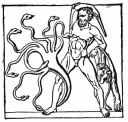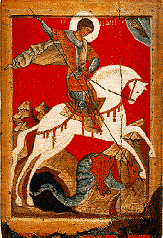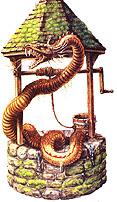
HYDRA
Origin: Norse/Greek Myth
HERACLES& THE HYDRA

Hera (Heracles's stepmother) decided that Eurystheus, and not Heracles, should become the king of Mycenae. Eurystheus commanded Heracles to perform twelve labors in twelve years in order to keep him away from his kingdom, afraid Heracles would take his throne. The Hydra was was Heracles' Second Labor, the first being the Lion of Nemean.
Eurystheus ordered Heracles to kill the Lernaean hydra. This hydra, raised in the swamp of Lerna, would go out into the plain and destroy both property and livestock. The hydra is a gigantic multi-headed dragon, with anywhere from 6 to 9 heads (depending on which version of the story you read) with the middle one being immortal. It's breath and blood were deadly.
He travelled to Amymone, where the Hydra's cave was near. After finding the hydra he forced it to come out by shooting burning arrows at the enterance. When the creature emerged, Heracles grabbed it and held on. The hydra coiled around Heracles' feet and tried to smother him with the huge coils of itself. Heracles' attempts to smash its heads with his club were unsuccessful, for whenever he smashed one head, two would grow where the one was originally. Additionally, a huge crab helped the hydra by biting Heracles' feet.
The crab however, was not immortal, so Heracles smashed the crab into mush. After killing the crab, Heracles called to Iolaus for help. Iolaus, after setting fire to part of the nearby grove of trees, stopped the heads from sprouting up by cauterizing the stumps with torches as they came up. Heracles, having killed all the other heads, he cut off the immortal head, buried it beside the road and put a heavy rock on top of it. With that done, he cut open the body of the hydra, and Heracles dipped his arrows in its deadly bile. Eurystheus, however, said Heracles could not count this labor among the ten, since he cheated by having Iolaus help him defeat the beast.
The Hydra has a constellation named after it .
SAINT GEORGE
Origin: English History

Saint George is known as a Martyr and the Patron Saint of England.
He was originally a Roman Calvary officer who was known for his courage in war. He was a mighty site on his white war-horse. He eventually converted to Christianity, and to show the people that Christians did not have to be meek, he sought out to fight a dragon who was destroying the area around Cappadocia. The people of the town tried to calm the beast with sacrafices of their best sheep. This worked for a while, but then the dragon attacked again. The poor people had to give up what they thought would rid the animal of their town: a virgin princess. George slayed the dragon with the lance he had in his hand while charging with his huge steed. Because of this heroic deed, other Christian Knights sought out to save damsels in destress from dragons, and how dragons eventually got slaughtered into being just a myth.
Saint George's red cross that he wore over his armor became the banner of England. Saint George Feast Day is April 23rd. Reynold's Metals even uses a symbol of St. George as their logo!
To check out more information on St. George and the Dragon, click on these links!
St. George Pictures
Images of St. George
SIGURD & THE DRAGON FAFNIR
Origin: Norse Myth
Sigurd (also known as Siegfried) Volsung was told by the dwarf Regin to gain fame and power to slay a terrible dragon named Fafnir that guarded a huge mound of treasure.
Sigurd took up interest in this dragon, and recently was awarded with his father's broken sword (named Gram) which Regin forged back into one whole massive sword. Sigurd and the dwarf rode to find the fearless beast. What Sigurd did not know is that Regin's brother murdered their father to gain the wealth of the kingdom. This brother's name was Fafnir. Fafnir, because of his greed for gold and jewels changed his corrupt self into a massive dragon to protect his hoard better.
From what Sigurd knew of dragons, their tough,scaly hide on the top of the body was impregnable to any weapon. Regin suggested building a pit in which Sigurd could hide. So they both dug a pit outside of the dragon's lair. With Sigurd hiding, Regin covered the pit with branches. He waited hours for the dragon to come back from its daily visit to the watering hole nearby. Finally, a shadow covered the top of the pit, and Sigurd took the huge sword Gram in both hands and shoved as hard as he could up towards the exposed, soft belly of the dragon. With the dragon dead, Sigurd climbed out of his hiding place.
Regin then caved out the beast's heart to roast. When handing it to Sigurd to share, he burnt his hand and sucked on his fingers. Moments later he heard chattering, and surprised, looked up to see birds talking. They were saying how the dwarf was planning Sigurd's murder. He saw the truth in the dwarf's eyes and took out the sword and sliced off Regin's head. He went into the cave to claim the treasure as his own.
To learn more, look at The Sigurd Runestone
JORMUNGAND, THE MIDGARD SERPENT
Origin: Norse Myth/Scandinavia
This was the son of Loki and Angerboda. This serpent was expelled by Odin, and forced to encircle the earth and hold its tail in its mouth under the depth of the seas. Thor and the giant Hymir were fishing using an ox head as bait when something very powerful grabbed the hook. The gigantic head rose up out of the water, and Thor was ready with his hammer, but Hymir lost his nerve and cut the line. the serpent dissapeared beyond the waves.
Many ages past, then the Day Of The Last Battle came. This was a war with god against giant, deity against demon, and man against monster. The Midgard Serpent let go of its tail and uncoiled itself to go ashore to fight Thor, the only being that would be worthy challenge. They met on the beach, and Thor immediately slammed bolts of lightning at the monster. Jormungand snapped its jaws at Thor trying to bite him fatally, with no luck. Thor raised his War Hammer and slammed it on the skull of the dragon. With an massive roar the dragon died. Thor also died that day, suffacated from the dragon's venomous breath.
Read more about Jormungand-The World Serpent
THE LAMBTON WORM
Origin: English History

John Lambton, heir to the Lambton kingdom skipped out on church one Sunday, and decided to go fishing instead at the river Wear. When he tossed his line into the water something grabbed his line and yanked hard. He finally managed to bring whatever it was at the end of his line to shore, and to his amazement it was the most disgusting, ugliest creature he as ever seen. It was about 3 feet long, with slimy, blackish skin, with the head of a dragon. Repelled at the sight, Lambton just wanted to get rid of the beast. There happened to be an unused well nearby so he dragged the creature by the tail and tossed it into the deep, dark well.
That day changed John Lambton's world. When he looked into the evil creatures eyes, he saw himself. A person who did many wrongs, and wanted to correct them. A few years passed, and he made up his mind to redeem himself and all the bad things he did in childhood. He left his castle far behind and travelled to the Holy Land. Unknown to him, the wicked worm he caught years before grew in the well.
While John was away, the gigantic worm, now so huge it could wrap itself around a hill nine times, crawled out of its hiding place and terrorized the town. It killed cows, chickens, and even the townsfolk. Some brave townsmen tried to kill it, and once even sliced it in half, but to their amazement and dismay, the dragon would just join together again. The towns people then tried calming the great creature with milk (knowing the other legends of placating beasts). They filled a cow-trough with 20 gallons of milk. When the worm smelled this, it came out to drink, then sluggishly went back to its place in the hills.
When John Lambton came back from his deeds in the Holy Land, he saw to his horror, the beast he put upon the town. He went to a local witch to ask her advice on how to destroy the monster. She informed him that the only way to kill it, is if he wore a suit of armor with spikes all around the surface, and if he confronted it near the river where he originally caught it. The other thing the witch told him surprised him. He would have to kill the next living thing that he saw or if he didn't the Lambton name would be cursed for nine generations, and no heir would die at home.
Understanding the warnings, John decided to still at least try to get rid of the worm. He had a local blacksmith create the special armor and off he went to try to get the worm to follow him to the river. The worm, knowing that another victim was near raced to John. John with his sharp sword slashed at the monster, and the monster wrapped its coils around John not knowing the blades that stuck out of it... The creature fell in many pieces to the ground, and with John slicing them into very small pieces, the worm finally died.
When he was walking back to the castle, to his horror, he saw the next living thing. That thing was his father. Knowing that he could not kill his father, he killed his favorite dog instead trying to sacrafice that to the curse. It did not. So the Lambton heir has a terrible, tragic end to their lives, and they were never at home in the comfort of their own bed.
Read more about The Lambton Worm:
Legend Of The Lambton Worm
FolkMusic: The Lambton Worm
NIDHOGG / NIDDHOGG / NYDHOGG
Origin: Scandinavian/Germanic Mythology.
The monster serpent, hid in the pit Hvergelmer, which for ever gnaws at the roots of the ashtree Yggdrasil. Yggdrasil isknown as "The World Tree"which supports the universe. The tree is a place where the gods judge and continually gnawed on by the dragon trying to destroy the universe.
THE PIASA
Origin: North America
The Piasa. originated in North America, and was worshipped by the Algonquins. It had the body of a dragon, the head of a person, a lion's mane, and a tail twice as long as a person. This was a neo-dragon which lived near the Mississippi River. This dragon did not bother humans until it found dead ones and tried the meat. To its surprise, it liked the taste. It now hunded humans and abducted people to bring them back to its lair for dinner.
THE ETHIOPIAN DREAM
Origin: Ethiopia
There is another neo-dragon known as "The Ethiopian Dream." This type of dragon had four wings and two feet with claws. They have no breath, but they ate poisonous plants to make their bite and their scratches deadlier. They were large enough to kill elephants. Once four of them were reported to have woven themselves into a raft and sailed over the Red Sea to Arabia, where there was better places to hunt.
BEOWULF & THE DRAGON
Origin: Anglo-Saxon
(In Brief) This is a story itold in an eight-century poem written in Old English. It combines three major stories, which tell of Beowulf's battle with the monster, Grendel, whom he ripped an arm off Grendel during a struggle. The second story tells of his fight with Grendel's mother a watertroll beneath the waters of a lake. And the third story tells of his combat with a fire-dragon.
One of Beowulf's servents was in trouble, so he ran away to hide from the trouble he was in. The servent accidentally discovered a dragonhoard at a burial ground near the town. Thinking that a nice gold goblet would buy him out of trouble, the servent quietly took it, and ran back to the kingdom. The dragon woke up at night, and checked his treasure. Upon finding one of his favorite trinkets gone, the dragon was extremely angry. To vent its anger the dragon sweapt through Beowulf's lands and set fire to the villages.
Beowulf, even though he was up in age, decided he had to rid his land of this terrible dragon. He gathering a small band of the best warriors and went off to find this creature. He gathers up some warriors and heads off to find the dragon. A young man of the group, Wiglaf begs Beowulf to help him fight the dragon, but he refuses and goes t the dragon alone. At the cave enterance, Beowulf challenges the dragon to come out so he could destroy it. The dragon belched flames at him as Beowulf raises his shield against the burning fire. He rushes the dragon and strikes the dragon, but breaks his sword. He reaches for his dagger but is too late as the dragon bites him.
Wiglaf rushes to the King's side and jams the sword into the soft underside of the dragon's jaw. The dragon lets go and Wiglaf and the King hack the dragon until it collasped. The poison from the dragons mouth was killing Beowulf. Eager to please the King, Wiglaf grabs an armful of treasure to show Beowulf. The king gives Wiglaf his helmet and ring, and tells him he is King of the Geats now.
To read the whole Poem, and learn more check out these links:
The Poem: Beowulf
The Beowulf Website
SMAUG
Origin: Tolkien Stories.
In the famous story "The Hobbit", Smaug was a dragon who guarded the Dwarven riches in Lonely Mountain. Bilbo Baggins a hobbit, Gandalf a wizard, and a band of 13 dwarves go on an adventure to reclaim the mountain of the dwarves and the riches that are deep inside.
Pictures of Smaug


0 comments:
Post a Comment